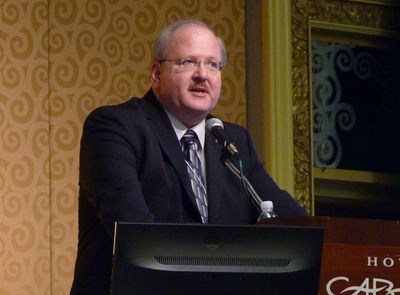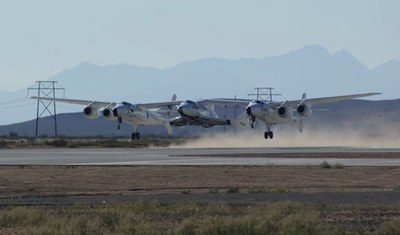Suborbital gets seriousby Jeff Foust
|
| “Tourists had a head start on us, but this is getting real,” Stern said of suborbital research. |
In the last few years, though, the role those vehicles can play in research, from astronomy to materials science to biomedical studies, has earned an increasingly prominent role. The best gauge of this trend is the Next-Generation Suborbital Researchers Conference (NSRC), the third iteration of which took place last month in Palo Alto, California. As turnout has grown—roughly doubling from the first NSRC, held two years ago in Colorado—the focus of conversations at the conference has changed, from what kinds of research could be performed on such vehicles to the technical details about flying those experiments, as well as the perceptions about suborbital research and spaceflight in general.
“Tourists had a head start on us, but this is getting real,” said Alan Stern, associate vice president for Southwest Research Institute (SwRI) and a former NASA associate administrator for science, who is perhaps the most prominent, and prolific, advocate for suborbital research. He has made the case that the “research and education market”, or REM, could some day be even bigger than tourism, in part because researchers will make multiple flights to carry out their experiments while tourists may see suborbital missions as a once-in-a-lifetime experience.
Stern, though, is more than just a spokesman for the suborbital research community: he’s a customer, too. Last year SwRI bought several seats on both Virgin Galactic and XCOR Aerospace flights. At this year’s conference, he announced that SwRI reached an agreement with XCOR to move up two of the six flights it purchased last year into the test program for XCOR’s Lynx suborbital spaceplane. “This gives us another competitive advantage,” he said of the decision, adding the move would also help XCOR demonstrate “that they’re really serious about the research and education market.”
Many of the conference attendees from the research community are early adopters as well: after all, the key benefits of suborbital vehicles—high flight rates, low per-flight costs, and human-tended experiment capabilities—have yet to be demonstrated. “You have the advantage of being early, and therefore first,” for those institutions that want to create suborbital research programs, Stern said. That, he added, can help overcome the higher prices associated with earlier missions, before flight rates increase and prices drop. “If your university foundation can’t turn a $200,000 ticket into a $2 million fundraising opportunity to be the first to fly from your university, then there’s something wrong with the people at your university foundation.”
As was the case with last year’s conference in Orlando (see “Getting down to the nuts and bolts of suborbital research”, The Space Review, March 14, 2011), this year’s NSRC had a focus at least as strong on how to carry out suborbital research as the types of research that could be performed. Alongside the sessions on the scientific research and technology demonstrations proposed for these vehicles were also many sessions on topics such as payload integration, mission planning, and training.
| “If automation was so great,” Stern said of arguments against sending people on suborbital research flights, “why aren’t geologists sending robots out on all their field expeditions?” |
While this work is primarily being done by private vehicle developers and university researchers, NASA is playing a role to stimulate interest in suborbital research through its Flight Opportunities program, which pays for flights of payloads on suborbital vehicles as well as on parabolic aircraft flights. “We look at ourselves as a broker”, said Laguduva “LK” Kubendran, program executive for the Flight Opportunities program withing NASA’s Office of the Chief Technologist. “We have users wanting flights, and then you have flight providers wanting users. We bring them together.”
The Flight Opportunities program recently closed its third round in an ongoing solicitation of payloads for parabolic or suborbital flights. “Things are looking pretty good,” said Dougal Maclise, the Flight Opportunities payload manager. There were concerns when the number of proposals dropped in the second round, but “now they’re starting to pick up and we believe it’s just going to keep growing from there.” According to the data he showed, more proposals were submitted in the third round—35—than in the first two combined.
 XCOR Aerospace president Jeff Greason blamed the media for the perception that the emerging suborbital industry is “about flying rich playboys to space”. (credit: J. Foust) |
The growing interest in suborbital research is attracting other companies to the field as well. The David Clark Company, best known for developing pressure suits and spacesuits for NASA and the Air Force, showed off its Contingency Hypobaric Astronaut Protective Suit (CHAPS) pressure suit, designed for use on commercial suborbital vehicles. CHAPS went through some centrifuge tests at the NASTAR Center outside Philadelphia last November; Stern, who wore the suit in the centrifuge at accelerations of up to 6 G, said the suit was “really comfortable” even at high G’s.
However, there remains an undercurrent of criticism about suborbital research, including the perception that those involved are doing so simply because they want a ride into space. Such people, said Stern, are “saying that when we talk about payload specialists, and people flying with their experiments, it’s about a joyride.”
Stern, of course, disagrees with that assessment. Having a person in the loop, he said, results in higher reliability and lower costs for experiments since there’s no need to automate the payload. Automation was necessary in the past for spaceflight when it simply wasn’t feasible to send researchers along with every payload, but the new capabilities offered by next-generation suborbital vehicles changes that equation, something he said takes some getting used to. “If automation was so great,” he said, “why aren’t geologists sending robots out on all their field expeditions?”
At a higher level, though, the suborbital industry is trying to argue that suborbital spaceflight is more than just joyrides, be it for scientists or the wealthy. Jeff Greason, president of XCOR Aerospace, made an impassioned plea for a reconsideration of the industry in a plenary address at the conference, based on the perceptions of the industry he argues the media has promulgated.
“In a nutshell, the way that they perceive this industry is that’s about flying rich playboys to space,” he said. “And that is a lie.” He believes that it comes in part from reporters who are not technologically savvy who are looking for some way to “sneer” at some area of technology they don’t understand.
| “I assure you that, whatever our ideas are today” for suborbital research and other applications, Greason said, “in ten years they’re going to look very antiquated.” |
The people who have signed up for suborbital spaceflights, Greason said, are doing it not because—or at least not just because—it promises to be a fun experience. “They’re doing it because they think they’re participating in something important. They think they’re participating in something meaningful. They think that their dollars and their time are paving the way to the beginning of something that could be a very important chapter in the future of humanity. And I think they’re right.”
Part of that perception, though, is the industry’s own doing. For many years, dating back to the development of the X PRIZE in the mid 1990s and certainly after SpaceShipOne won the prize in 2004, space tourism was promoted as the leading market that such vehicles could serve. The X PRIZE Foundation’s Peter Diamandis often joked that the mass market for spaceflight would be “self-loading carbon-based payloads that you can make at home”—i.e., people.
That vision of suborbital space tourism certainly attracted a lot of interest and attention and even investment, but it can look a bit out of tune in a more fiscally austere time like today. So now there’s more attention to other applications, like suborbital research—never really ignored, but alone not sufficient to speed development of vehicles—that can take advantage of low-cost frequent access to space and, perhaps, revolutionize science and technology in unforeseen ways.
Greason said there are plenty of ideas of what people can do with “routine, reliable access to space” but that, much like early ideas for the uses of personal computers (organizing recipes, anyone?) they will be overshadowed by others as people brainstorm new ways to take advantage of a capability not available today. “I assure you that, whatever our ideas are today, in ten years they’re going to look very antiquated.”
Those “playboys”, and those researchers seen by some as seeking joyrides, Greason concluded, “are enabling a sector of the human planetary economy that is going to be just as important and just as enabling in the 21st century as aircraft were in the 20th and oceangoing vessels were in the 14th. And they deserve our thanks.”
